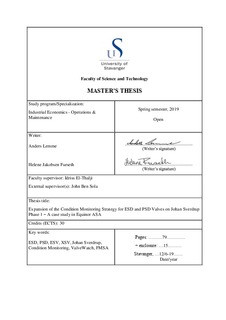| dc.description.abstract | The “Northern Giant”, Johan Sverdrup, is the biggest oil and gas field development on the Norwegian Continental Shelf in over 30 years. The field has an expected lifetime of 50 years, where it will provide value for asset owners and society. At maximum production, the field will produce 660,000 barrels of oil per day, which will be 25% of the entire oil and gas production in Norway. Equinor is the operator of the field, which has a planned production start in November 2019.
When Johan Sverdrup is in operation, the production needs to be reliable, cost efficient and safe. To ensure a safe state for the facility, safety barriers like emergency and process shutdown systems are in place. These systems will shut down affected processes, areas or equipment should an unwanted incident occur. The shutdown can range from a single valve to a complete shutdown and evacuation of the facility.
Some of the most critical equipment regarding safety systems is the emergency and process shutdown valves, which have strict requirements regarding performance and reliability. Function and leak testing are currently the preferred method of verifying the condition of the valves. These tests are typically performed every 12 months and reported to the Petroleum Safety Authority of Norway. The testing requires resources and production downtime to be performed.
The purpose of this thesis is to illuminate the effectiveness and potential benefits by expanding the use of condition monitoring on emergency and process shutdown valves. This can increase the reliability of the valve and explore the possibility of utilizing condition monitoring to perform function and leak testing more efficiently. The thesis will also include an estimate of the potential cost saving related to a decrease in downtime due to condition monitoring.
To illuminate this potential, an analysis has been developed to match the most likely valve degradations with relevant condition monitoring equipment’s ability of indicating the degradation. The analysis was used to determine which sensors has the highest coverage degree of failures and then how the use of sensors can be expanded on Johan Sverdrup. A result matrix was developed to assist in choosing which sensors should be installed on which valves, dependent on the valve requirements and function.
A potential savings estimate has been performed to indicate the loss of revenue related to production downtime. By utilizing condition monitoring on emergency and process shutdown valves, the corrective maintenance and annual testing can be done more efficiently and therefore decrease the necessary production downtime. There is a major potential for cost savings due to the production downtime related to testing.
The results of the analysis show that most failures on automated valves can be detected by condition monitoring technology. The sensors are effective for continuous surveillance of the valves, troubleshooting during maintenance and for streamlining testing. By using condition monitoring on emergency and process shutdown valves, failures can be detected before they become so severe, they will affect the reliability of the valve as a safety barrier. Additionally, the potential savings estimate shows a potential saving of 1.31 million USD per hour of maintenance saved.
The thesis development and analysis are a case study at Equinor. Discussions and meetings with Equinor personnel and suppliers, combined with internal documentation and industry standards, forms the foundation of the thesis. | nb_NO |
